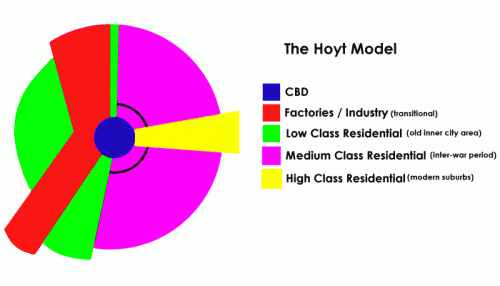The high school curriculum overlooks a great many subjects, so we could go on at length pointing out its ironies and shortcomings. But the topic at hand happens to be urban planning, so let's stick with that.
The high school curriculum overlooks a great many subjects, so we could go on at length pointing out its ironies and shortcomings. But the topic at hand is urban planning, so let's stick with that.
I would never want to inflict the intricacies of urban planning on the casual student, slogging through high school or college distribution requirements. Memorizing ordinances and calculating optimal curb heights is no way to inspire young minds to think about their cities and how to make them better. On the other hand, basic understanding of urbanism and planning would seem appropriate, if not essential, for the 90 or so percent of American kids who grow up in the cities and suburbs that have resulted from modern planning principles and whose lives are, by extension, dictated by planners. Let's throw in the 10% who live in rural areas too.
There is something unnerving about a curriculum that enables students to remain completely ignorant of the very surroundings in which they live. I'm certain that almost no student understands the forces that colluded to produce their respective culs-de-sac, housing projects, mansions, or homesteads. Nor would it occur to most of them to find out. Laypeople approach the built environment with the patently contradictory attitude that it came about as an act of nature and--despite kids' natural curiosity about the world--that it therefore offers no opportunities for inquiry or betterment.
College is supposed to fill those gaps and nurture the dreams that high school ignores. But running across urban planning in the course catalog is different from, say, running across Slavic literature. You can at least guess at the latter even if you have no firsthand experience with it; the former offers little but mystery. That is to say, the typical college freshman doesn't even know what planning is--so how can he or she be expected to spend precious credits finding out whether it is worthwhile?
If American cities are to heal themselves, and if the planning profession wants to attract the brightest students from the widest possible talent pool, urban planning must find its way into the high school curriculum.
The closest most high schools come to planning consists of passing references to architecture in art history courses. This is a tenuous connection, at best. Even so, art history presents architecture only as individual works--often as examples of styles or historical periods--not as elements of a built environment, and never as profound forces that affect everyday life.
But changes are afoot.
Eight years ago the College Board brought the often marginalized field of human geography into the mainstream by creating an Advanced Placement course. It came about at the urging of a host of professional geography organizations, including the Geography Education Implementation Project, the National Council for Geographic Education, and the American Association of Geographers. Say what you will about the College Board's powers of arbitration. It has sucked the life out of many subject. In this case, however, it has done the curriculum a great favor by legitimizing geography and approving it for high schoolers' consumption.
AP Human Geography--which I taught for four years at a private school visionary enough to adopt it as its culminating, senior-year history class (and brave enough to let me teach it)--does not, of course, focus solely on urbanism. It runs the gamut of other mysterious, but fascinating, fields such as anthropology, economics, demography, and sociology. These subjects are not only absent from most high school curricula but also are valuable for anyone who will one day flip through a college catalog or otherwise walk this earth. But among those topics, urbanism makes its stand. AP Geo typically includes two solid units of urbanism, one on urban systems and the other on urban structure. That's where planning comes in.
Obviously a two-week peek at urban structure reveals little of the profession--but nor should it. Instead, it offers students the chance to contemplate cities and evaluate, in broad strokes, the theories and practices that made have made cities what they are. The course trods over ground that the profession has probably long abandoned: Is the Hoyt Sector model useful? Do stores still consider threshold and range in the age of e-commerce? Did redlining happen, or is it a myth propagated by liberals? Does the bid-rent curve reflect land values properly in a multiple-nucleus city? Who cares?

The answers that AP Geo provides are not nearly as important as the questions, or, rather, the opportunity to ask questions. Even simplistic, outdated theories provide invaluable foundations for further inquiry--even if that inquiry proves the original assumption wrong. Moreover, the course can embrace some of the urban canon, many of whose works are as compelling as any nonfiction ever written.
I remember when I first read Jane Jacobs and Kenneth Jackson. I was 25. My life would have been different indeed if I'd read them at 17, as my students have. I don't expect them to become planners, but I do expect that they will at least be better urban citizens than they otherwise would have been.
Despite its potential, AP Geo is not about to challenge AP Physics or AP US History for a place in high school's top shelf. Though the numbers grow every year, only about 20,000 students took last year's exam. Many of those students hail from states with mandatory geography requirements. But that's a few thousand more students who graduate high school knowing more about cities than most of their counterparts--which is usually less than zero.
Until Planetizen publishes "Urban Planning for Dummies," AP Geography is our best hope. And it's not a bad way to spend a couple semesters.

Planetizen Federal Action Tracker
A weekly monitor of how Trump’s orders and actions are impacting planners and planning in America.

Map: Where Senate Republicans Want to Sell Your Public Lands
For public land advocates, the Senate Republicans’ proposal to sell millions of acres of public land in the West is “the biggest fight of their careers.”

Restaurant Patios Were a Pandemic Win — Why Were They so Hard to Keep?
Social distancing requirements and changes in travel patterns prompted cities to pilot new uses for street and sidewalk space. Then it got complicated.

Platform Pilsner: Vancouver Transit Agency Releases... a Beer?
TransLink will receive a portion of every sale of the four-pack.

Toronto Weighs Cheaper Transit, Parking Hikes for Major Events
Special event rates would take effect during large festivals, sports games and concerts to ‘discourage driving, manage congestion and free up space for transit.”

Berlin to Consider Car-Free Zone Larger Than Manhattan
The area bound by the 22-mile Ringbahn would still allow 12 uses of a private automobile per year per person, and several other exemptions.
Urban Design for Planners 1: Software Tools
This six-course series explores essential urban design concepts using open source software and equips planners with the tools they need to participate fully in the urban design process.
Planning for Universal Design
Learn the tools for implementing Universal Design in planning regulations.
Heyer Gruel & Associates PA
JM Goldson LLC
Custer County Colorado
City of Camden Redevelopment Agency
City of Astoria
Transportation Research & Education Center (TREC) at Portland State University
Camden Redevelopment Agency
City of Claremont
Municipality of Princeton (NJ)






























